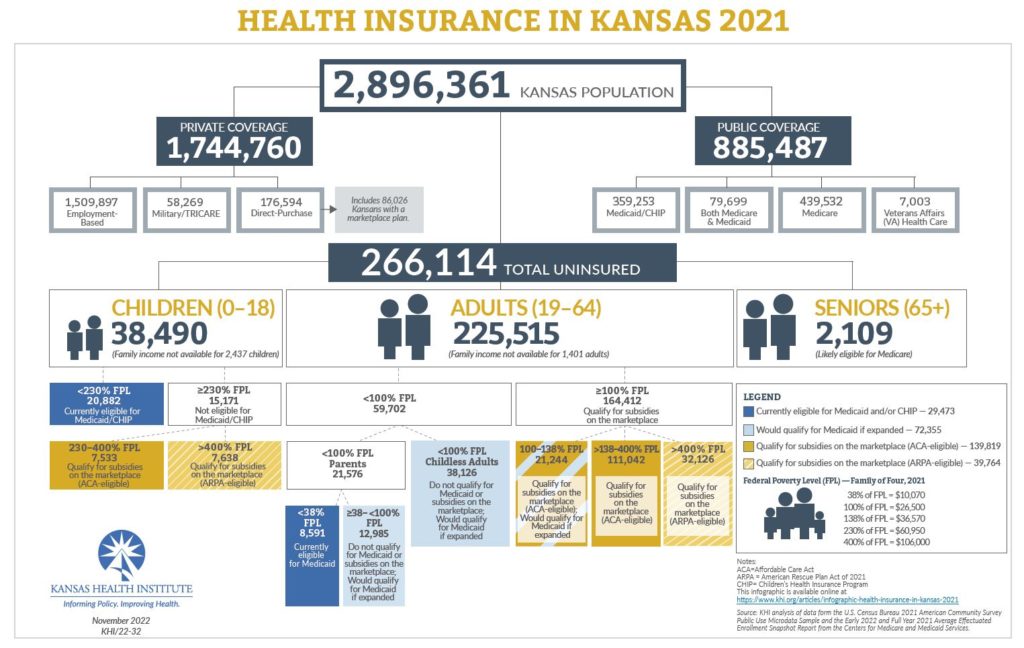Health insurance is considered essential to access high-quality healthcare and offers protection from excessive medical bills. Throughout the year, the Kansas Health Institute (KHI) provides detailed information about insurance coverage in Kansas to enrich ongoing discussion of health coverage options in Kansas and on the national level. This infographic provides our first glimpse of recently released detailed data from the U.S. Census Bureau. Over the coming months, follow us on Twitter, Facebook or LinkedIn, and check out www.khi.org frequently to get more information as it becomes available.
This infographic provides a high-level overview of insurance coverage for 2,896,361 Kansans in 2021.
Highlights include:
- More than 1.7 million Kansans were covered by private insurance, including:
- 1.5 million by employment-based coverage,
- 58,269 by military or TRICARE insurance, and
- 176,594 by directly purchased insurance, including 86,026 who purchased coverage on the Kansas marketplace created by the Affordable Care Act (ACA).
- Another 885,487 were covered by public insurance, including:
- 439,532 by Medicare,
- 359,253 by Medicaid or the Children’s Health Insurance Program (CHIP),
- 79,699 by both Medicare and Medicaid, and
- 7,003 by Veterans Affairs health care.
- And 266,114 Kansans were uninsured, including:
- 225,515 nonelderly adults, and
- 38,490 children.
Federal and state policies supported access to health insurance coverage during the COVID-19 pandemic. Medicaid and CHIP enrollees were allowed to remain enrolled without redetermination, and subsidies to purchase a plan on the ACA marketplace were made more generous and were expanded to households with income above 400 percent of the federal poverty level (FPL; $26,500 for a family of four in 2021).
The American Rescue Plan Act of 2021 (ARPA) made households above 400 percent FPL newly eligible for a marketplace subsidy in 2021 but the amount they received depended on the benchmark plan premium and their household income. Households may have received $0 if the premium for their benchmark silver plan was less than 8.5 percent of their annual income – the effective maximum income to receive a subsidy.
Two-thirds (179,583 or 67.5 percent) of uninsured Kansans in 2021 had household income that would have qualified them for subsidies to purchase health insurance on the Kansas marketplace. Among those who would have qualified, 139,819 (77.9 percent) would have qualified for subsidies to reduce monthly premiums under the original terms of the ACA and 39,764 (22.1 percent) would have newly qualified for subsidies under ARPA.
As of November 2022, Kansas is one of 11 states that has not expanded Medicaid coverage to adults with household income up to 138 percent of FPL, as allowed by the ACA. South Dakota became the 39th state to expand Medicaid after a ballot initiative passed on November 8. In 2021, Medicaid expansion would have covered individual adults with annual household income up to $17,744 and adults in a four-person family with annual household income up to $36,570.
If the state had expanded its Medicaid program in 2021, 72,355 low-income, uninsured Kansas adults would have become newly eligible for Medicaid coverage.
Another 29,473 low-income uninsured Kansas adults and children were likely already eligible for Medicaid or CHIP, but were not enrolled
NOTE on data:
This infographic uses the latest-available data, which come from the 2021 American Community Survey Public Use Microdata Sample from the U.S. Census Bureau and the Early 2022 and Full Year 2021 Average Effectuated Enrollment Snapshot Report from the Centers for Medicare and Medicaid Services. The Kansas population presented is the non-institutionalized population in Kansas. Estimates of the number of Kansans eligible for Medicaid or qualifying for marketplace plans and subsidies are based on the Census Bureau definition of household units, which consist of all individuals currently residing in the sampled household, regardless of how members of the household are related. Actual experience may differ, as eligibility determinations for Medicaid and the health insurance marketplace include other considerations.
This Infographic is part of our Annual Insurance Update series.
